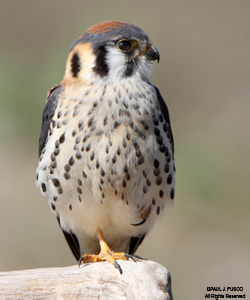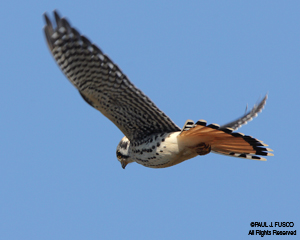American Kestrel
Falco sparverius
State Species of Special Concern
Background
The American kestrel is a small, slender falcon that is about the size of a robin. It is found in open habitats that have plenty of nesting cavities and hunting perches.
Kestrels can be seen in the state throughout the year. They are considered uncommon residents in winter and somewhat common migrants in fall and spring. Migrant populations increased during the early 1900s but breeding populations were comparatively low. Kestrels were more numerous when agriculture was at its peak in Connecticut. Currently, with the disappearance of agriculture, along with the regrowth of forests and an increase in suburban development, open, grassy areas are in short supply. This change in Connecticut's landscape has caused many wildlife species that rely on open areas, including the kestrel, to experience long-term declines. Kestrels also were negatively affected by the use of organochlorine pesticides, such as DDT. DDT was banned from use nationwide in 1972.
The American kestrel was listed as threatened on Connecticut's Endangered, Threatened, and Special Concern Species List in 2004, primarily due to a lack of information, coupled with a perceived decline in nesting and migrating numbers and diminishing habitat. It was down-listed to special concern in 2015.
Range
American kestrels are found throughout most of North and South America. Most of the kestrels that breed in North America overwinter in the United States and Mexico, although a small proportion migrate as far south as northern South America.
 Description
Description
The American kestrel is the smallest falcon found in North America. Like most falcons, kestrels have long, pointed wings and long tails. The birds are easily recognized by two vertical black lines on the cheeks and a rufous-colored back and tail. The female has rufous-colored wings while the male has black-banded, bluish-gray wings. This species is the only falcon in which the male and female show such a marked difference in plumage. The kestrel ranges in size from 9 to 12 inches long with females being larger than males.
Habitat and Diet
Kestrels prefer open grassy or shrubby areas with short vegetation in which to hunt for their prey. In Connecticut, kestrels are usually seen around agricultural areas (hay fields, orchards, pastures), airports, large parks, and power line right-of-ways. Meadows, grassy fields, and old fields also may be inhabited. It is not unusual to find kestrels using urban and suburban areas and even buildings (barns, silos, cornices) for nest sites. Kestrels require natural tree cavities or nest boxes for nesting, along with perches in the form of trees, shrubs, or telephone poles.
The kestrel's diet varies seasonally and consists mainly of insects, including grasshoppers, crickets, beetles, dragonflies, butterflies, moths, and cicadas. Mice, voles, shrews, small snakes, frogs, and small birds also are eaten. Kestrels typically hunt from a conspicuous perch, although they occasionally hover over an open area when perches are lacking.
Life History
Connecticut's nesting kestrels begin courtship in late March to early April. An average of 4 to 5 brown-spotted eggs are laid by the end of April in a natural tree cavity or man-made nest box on little or no nesting material. They are incubated, primarily by the female, for 29 to 31 days. Males catch most of the food for the brooding female and, later, for the developing young. Usually 3 to 5 chicks are hatched and will grow quickly. The chicks are ready to fledge (reach flying stage) about a month after hatching. After fledging, the young stay with the adult birds for several weeks. In Connecticut, American kestrels will usually have 1 brood per season and will renest if the first nest fails.
Interesting Facts
Another name for the kestrel is the sparrow hawk, although birds are not a main prey item.
Kestrels have a habit of pumping their tail feathers up and down when perched, especially after landing. They are known for their rapid flight and have been recorded to fly between 22 and 39 m.p.h.
Kestrels are quite vocal. Their call is a loud, repeated "killy, killy killy" when they are excited or alarmed.
American kestrels do not need to drink free-standing water. They get all the water they need from the moisture of their prey.
Some of the predators that hunt kestrels are great-horned owls and red-tailed hawks. Other predators that have been known to attack raptors include coyotes, bobcats, skunks, raccoons, crows, and ravens.
Populations of the larger Cooper's hawk increased throughout northeastern North America from 1976-2003, and studies at Hawk Mountain Sanctuary, in Pennsylvania, and elsewhere have suggested this species preys on kestrels.
Kestrels are protected by the federal Migratory Bird Treaty Act of 1918 and Connecticut General Statutes Sec. 26-92 and Sec. 26-311 (threatened and endangered species legislation).
Conservation Concerns
According to Hawk Mountain Sanctuary, data from raptor migration counts, Breeding Bird Surveys, and Christmas Bird Counts indicate that American kestrel populations have declined in much of northeastern North America (including Connecticut) since 1974. Loss of habitat is the most likely cause of the kestrel decline in Connecticut. The number of farms in the state has been decreasing, many old agricultural fields are returning to forest, and suburban development has replaced suitable habitat. A lack of available nest cavities also can limit the number of kestrel breeding pairs.
What You Can Do
Because kestrels do not excavate their own nesting cavities, they seek out ready-made homes, such as abandoned woodpecker holes or nest boxes provided by people. Specially-made nest boxes have helped kestrels throughout the country in areas where there are few natural cavities. Nest box programs for kestrels enable populations to increase in locations where nest sites are limiting. If you live near suitable habitat, you should consider providing and maintaining nest boxes for kestrels (Plans for constructing a kestrel nest box, courtesy of Art Gingert). To be successful, nest boxes should be placed in open field habitat. Preferred habitats are grasslands, pastures, orchards, and hay fields with cover at about 10 inches high. Nest boxes require continuous maintenance and should be monitored to prevent non-native starlings from using them. A program to promote natural nest sites (cavities in snags) should occur along with a nest box program.

The production of this Endangered and Threatened Species Fact Sheet Series is made possible by donations to the Endangered Species-Wildlife Income Tax Checkoff Fund.
(rev. 12/19)

